Considerations When Planning Next Large-Scale Complete Streets Project
Case Study: Wilmington Pike and Feedwire Road Roadway and Intersection Improvements
Construction was recently completed on the multi-phase project which took a major intersection within Montgomery County from 3-lanes to 9-lanes at the largest point. Already a highly traveled area in the county, a new adjacent development was driving the need for improvements at a large scale. The project area is populated with many retail establishments, restaurants, and homes. All of these stakeholders would be impacted by the development that included Costco, Kroger Marketplace, Cabella’s, and additional outparcels with smaller retail and restaurant space.
The Kleingers Group worked closely with the City of Centerville, homeowners, business owners, and other stakeholders to ensure the design would meet increased traffic capacity needs, accommodate pedestrians, and help keep area businesses operational.
Below are examples of things to consider when planning your next large-scale complete-streets, roadway design project.
Minimizing the Impacts on Businesses Through Design
Maintenance of traffic (MOT) in any roadway project can make or break the businesses affected during construction. Kleingers found challenges throughout the three phases of the project but worked to address or even predict each one.
Number one, the entire project scope (all 3 phases) was designed early in the process to ensure that each end of the project would have the least impact on the right-of-way, and ultimately the existing businesses along with the design. Creating this initial master plan allowed our engineers to create a design that provided no disruption to the area businesses. For some businesses, losing parking spaces could mean closing their doors. Because of Kleingers’ universal look early in the design process, no parking stalls were affected during construction or lost after completion of the project. Kleingers’ worked with the city to help predict future phases and affected areas to ultimately help save money.
Speaking of saving money, and resources, Kleingers’ carefully coordinated plans to help save on temporary paving costs by salvaging pavement from other phases of the project. The salvaged pavement was used to reduce construction costs where temporary pavement was needed for maintaining 2-lanes of traffic.
Not only was the area already highly populated, but the thoroughfare was an important route for nearby hospitals and other emergency crews. Kleingers coordinated with local hospitals, the city, and its emergency services departments to ensure 2-lanes would remain operational during the life of construction so that emergency crews could operate, business as usual.
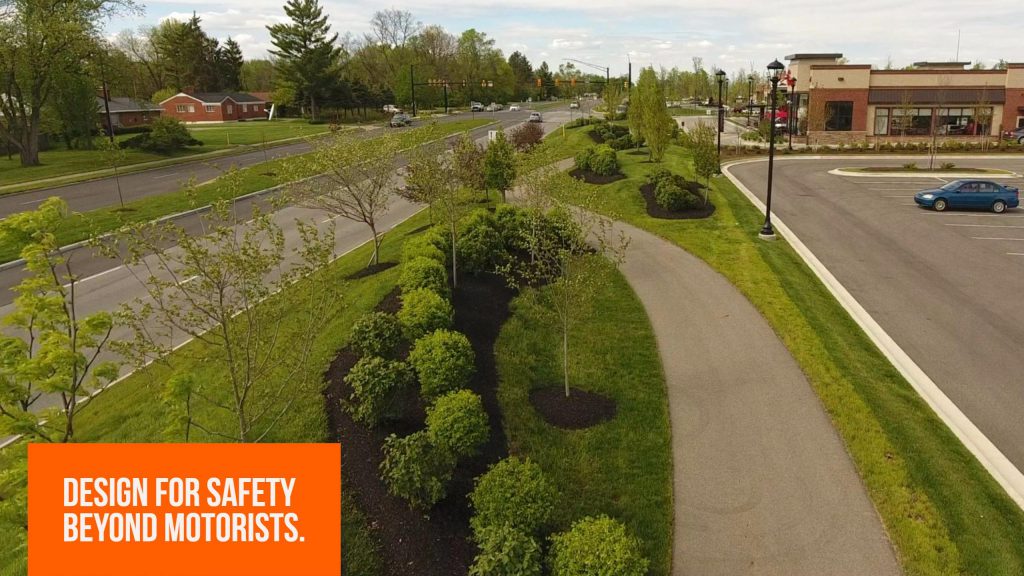 More than Just Roadway Improvements – Complete Streets
More than Just Roadway Improvements – Complete Streets
Complete streets are defined as ‘streets for everyone’ and ‘a means to make it easy to cross the street, walk to shops, and bicycle to work.’ The Wilmington Pike and Feedwire Road project was designed to address safety for all travelers beyond motorists, including pedestrians, bicyclists, and transit riders.
With traditional sidewalks provided on one side, 8-foot wide meandering paved trails, and a concrete bus stop for Dayton RTA riders, the project was challenged with not only creating the means for safety but also creative drainage solutions.
Our traffic engineers took into account ADA and pedestrian safety when designing for three traffic signals along with the project. The design provided key elements such as voice-activated pedestrian push buttons that are timed and integrated with the signal system; ADA curb ramps; and landscape mounds along with the development which obstructs headlights that beam into on-coming traffic. The project also incorporates a pull-off bus stop for Dayton RTA riders along with ADA access and a gazebo that protects transit riders. All of these elements working together provide safe access for pedestrians and bicyclists in the area.
The city looked to Kleingers to help find the balance of economics when comparing adding more right-of-way (ROW) costs or providing environmental and water quality structures to address drainage design. Typically, on most projects where adding more ROW to a project has little impact on local businesses or homeowners, the simple solution is to create larger ditches to handle drainage runoff. In this particular project where the project was constrained by several existing businesses, the cost-effective solution to drainage was to add water quality structures. In doing so, the designers were able to also address environmental concerns while maintaining precious ROW.
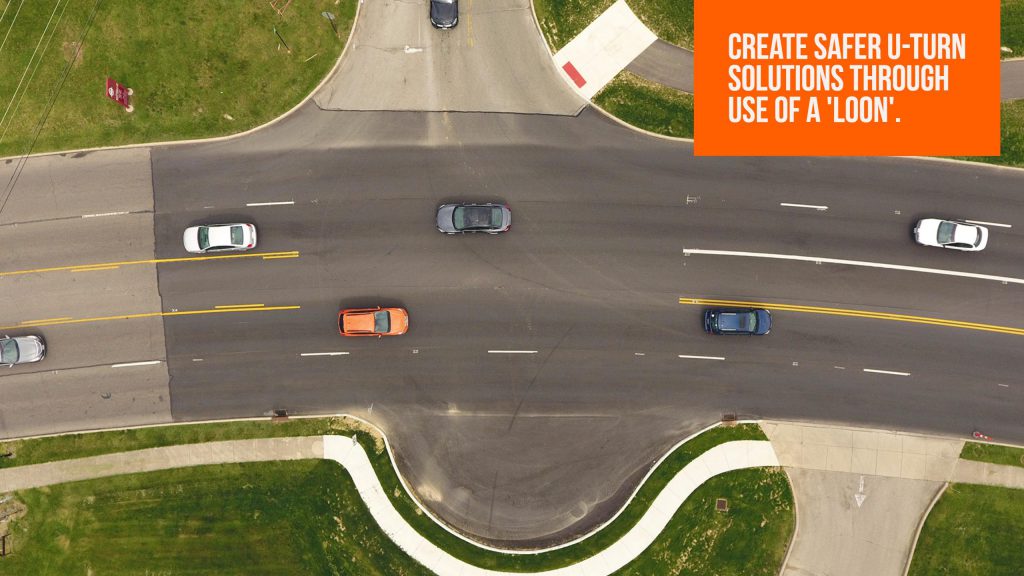 The Loon – Designing Safe ‘Out-Of-The-Box’ Solutions for U-Turns
The Loon – Designing Safe ‘Out-Of-The-Box’ Solutions for U-Turns
Roadway engineers are continually looking for ways to improve vehicular and pedestrian safety. A rare, ‘out-of-the-box solution for drivers who want to safely cross or make a U-turn on a divided roadway is through the use of a ‘Loon through-turn’ design. So, what is a loon? The loon is pavement that is constructed outside of the normal traffic lane within the right-of-way space. This additional area allows vehicles, especially larger ones, to safely make a U-turn on a roadway divided by a median.
Where lanes were widened to accommodate the increase in traffic, a median was created to provide safer access for those who live along this stretch of road. The installation of the loon helps those who have headed northbound access their homes on the other side of the new median without the safety implications of crossing large amounts of oncoming traffic.
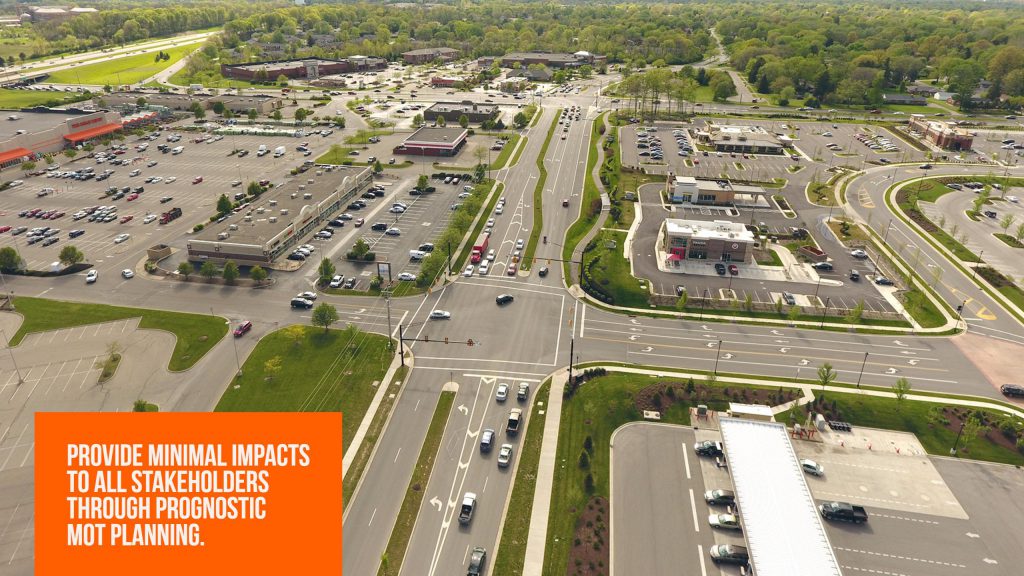 Predicting Construction Conflicts in A 3-Phase Project
Predicting Construction Conflicts in A 3-Phase Project
Often, unforeseen construction issues are a leading contributor to increased construction costs during a project. Kleingers considered all aspects of construction coordination between project phases when designing the roadway improvements, such as drainage, utility coordination, elevation changes with a neighboring development project, and much more.
The Kleingers’ team was able to provide contractors with finished elevations for coordination of major utilities, including water mains, gas mains, and power distribution lines. By telling contractors exactly where to locate lines, even in areas that had not been graded for elevations, those utility contractors could be on-site once during the life of the project without additionally impacting the schedule later in construction. It also meant that site contractors would have to grade the site less and fewer materials would be required, ultimately saving time and money.
By working alongside the designers for the adjacent site development project, The Kleingers Group could provide regular updates on a continuous basis. Adjusting for site elevation, drainage, and utility changes during the project’s design phase. This allowed Kleingers to maintain continuous control of the project while in the field. This extra coordination helped Kleingers quickly accommodate for construction surprises in the field, helping to alleviate downtime on the project.
In summary, a successful large-scale complete street project will require close coordination among all stakeholders during the design phases to mitigate common budget and schedule busting events.
Kleingers at the 2017 International Trail Symposium
The Kleingers Group recently spoke at the 2017 International Trail Symposium held in Dayton, Ohio. The educational conference brings together experts from all across the globe to learn more about trail system challenges, successes, and progressive ideas. We were inspired by so many ideas and conversations shared during the conference that we thought we would share some of our thoughts with you.
See our takeaways from speaking/attending below:
Sharing International Challenges and Successes
- Those in attendance during our speaking session included individuals from Brazil, El Salvador, Idaho, and New England (just to name a few). It was incredible to sit alongside others from all across the globe, discussing similar challenges, programs, and worldwide support for creating trails to connect people across the earth.
- Much like what we see in areas where we perform trail engineering and design services, many cities across the globe have been built around a single mode of transportation – cars.
- In general, Ohio has created many fantastic ‘destination trails’ where families travel by car, with bikes in tow, for recreation. Recreational communities across the state have done a great job creating these core recreation destinations. The challenge now is to create paths that connect these destinations with the people of the area.
Dayton Sets an Example for Others Across the Globe
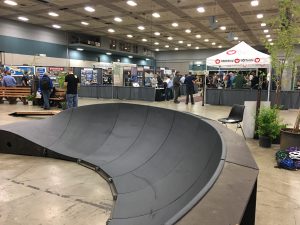
More than just trails and paths, extreme biking paths were demonstrated at the symposium.
- Dayton has such a rich history of those within the biking community. The Wright brothers and the founder of Huffy Bicycles both got their starts in the area.
- Dayton is home to the largest paved trail network in the United States.
- Following the Great Miami River flood of 1913, the Miami Conservancy District was both created and funded locally. The organization set out to build levees in the area and eventually turned its attention to focus on water activity and then trails.
- Many organizations across the country look to the conservancy as a leading example. The district has found ways to continue funding the program which helps maintain the trails in the area, including winter plowing, ADA upgrades, and more – typically a challenge for trail owners.
- The Dayton area is also known in the trail community for Huffy’s ‘Rails to Trails’ conservancy program developed in the 1970s, before converting old rail lines to bike trails was popular.
- Large metropolitan stakeholders across the globe are just now getting programs in place and look to the Dayton area as a leading example.
Changing our approach to trails through progressive examples for funding area complete streets.
- Historically, money is spent ordinarily on the right-of-way for roadways. Complete streets is a way of approaching how best to a projects’ right-of-way while generating modes of transportation and access for all-wheel riders (aside from cars).
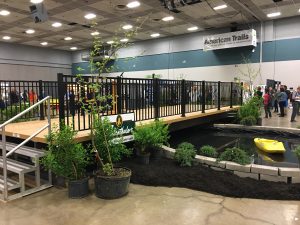
Prefabricated bridge showcased in the exhibit space.
How is The Kleingers Group affecting change in the area?
- As one example, Kleingers currently serves as the City of Wilmington, Ohio’s municipal engineer. We have been working with the city to set in place an active transportation plan which focuses on multi-modal transportation with complete street elements so that when new projects are completed within the city, they will comply with the program. The results will be a community that is not only multi-modal but a desirable place to live, work and play.
- Kleingers was recently awarded a fourth task order with ODOT for Safe Routes to Schools and Pedestrian Safety. We have an ongoing commitment to design multi-modal paths for school districts and local governments while creating a safe and healthy means of travel for students and families all across the State of Ohio.
Successful trails not only encourage healthy living and help reduce the carbon footprint; studies have shown they also increase property values for those adjacent to and in close proximity to the path. If we can consider the above successes, challenges, and creative approaches to constructing paths and trails for recreation and commuters alike, then we can (alongside others across the globe) create more desirable places to live and enjoy.
Kleingers Trains Miami Students to Build Water Systems in S. America

For more than 13 years, Engineers Without Borders has been building engineering projects that empower communities to meet their basic needs.
With 300 chapters across the United States, more than 15,900 volunteers work together to provide engineering services and have impacted more than 2.5 million lives.
Mike Brunner, Water Resources Group Leader at The Kleingers Group, is currently acting as a mentor for the group, helping to train Miami University students who plan to travel to Ecuador, South America or Rwanda, Africa. Under the guidance of a mentor, the students will provide engineering services to build water systems that ensure the communities have access to water.
In late September, Brunner helped the students learn a variety of hands-on skills and the practice of engineering and surveying theory, including how to run an elevation level circuit, mix and place concrete, construct water piping systems, and test concrete beams.
Particularly popular was the process of breaking beams, which was done by having increasing numbers of students stand on the beams, which were positioned 3 inches off the ground until they broke. This was preceded by reviewing the design calculations and making predictions of how many students it would take to break them and how much they would deflect before breaking.
At an upcoming meeting this weekend, Brunner will help teach the student volunteers about building masonry walls.
Each training session prepares students for civil engineering, surveying, and other experience they may need on their upcoming trip.
“I had been looking for an organization like this, with an opportunity to give back and work with students for a long time,” Brunner said. “This really is a wonderful organization.”
Engineers Without Borders is organized by local chapters that partner directly with communities, mostly international, on projects to meet the community’s self-identified needs. The vast network of dedicated volunteers ranges from first-year engineering students and engineering professionals to public health professionals.
The over-arching philosophy of EWB-USA is to partner with communities in a sustainable way, and through the use of appropriate technology, so that they have ownership in the project(s) and will be able to maintain the project facilities long-term.
Along with two or three other local professional engineers, Brunner meets weekly with the student volunteers to provide advice and direction on the engineering/technical aspects of the project, as well as to guide them through the development of the project documents and EWB-USA paperwork.
Two different teams of Miami students from the chapter, along with a mentor, traveled to Ecuador and Rwanda last year to gather survey data that is being used to design the projects and to meet the local community leaders and citizens. Trips for the construction phase are being planned for this year.
Kleingers Participates in ULI – East Central Regional Product Council
The Kleingers Group was pleased to participate as a guest of the ULI East Central Regional Product Council which took place in Pittsburgh, PA earlier this month. This select group of ULI members from the ULI Cincinnati, Cleveland, Columbus, Indianapolis, and Pittsburgh region focused on Urban Infill and Mixed-Use Development. As the host city, Pittsburgh provided an exceptional backdrop for a discussion on how an urban core is being redeveloped thanks to many key drivers for public and private investment.
The group began the session with a walking tour of the downtown area. The City of Pittsburgh has seen over $3 billion of investment completed over the last 10 years with another $2 billion in the planning stages. It has transformed from a steel city to a cultural mecca with over thirty theaters in the downtown area. Pittsburgh has a very dense, urban core with narrow right of way and relatively aged, historic buildings – a differentiator from Columbus. Mellon Square was once thought of as the “death of Pittsburgh” but is now a restored, elevated plaza surrounded by hotels, renovated office/residential buildings, and retail uses.
According to http://www.downtownpittsburgh.com, the redevelopment of residential housing within Pittsburg is rapid with 1,084 residential units opening since 2010 and 90.8% of apartments being rented at the end of last year. The average rental rates are higher than we are currently seeing in the Columbus area and mixed-income projects are prevalent.
Mixed-use buildings are somewhat the norm and green buildings are important to the office users in Pittsburgh. PNC is currently completing a new tower building rising 33 stories above the surrounding rivers with over 800,000sf of office space. This building is touted as the world’s greenest skyscraper and has dramatically changed the skyline of the City.
Along with the downtown area, the group toured East Liberty and Bakery Square, which are mixed-use redevelopments outside the urban core which include transit-based development and a new transit center. Transit and light rail are important to making these developments work and the City seems committed to transportation improvements including a new bike share program. The Bakery Square development has landed Google as a main office user in the redeveloped bakery building. A green street featuring permeable pavement and stormwater infiltration systems has been dedicated to public use and will be maintained by the City. This is one example of the commitment of both public and private entities together to not only implementing sustainable principles within the design and construction but also turning this new, green infrastructure over to City ownership and maintenance.
An All-Star panel discussion including representatives from the City of Pittsburgh, Urban Redevelopment Authority, Hillman Family Foundations, Heinz Endowments, and Pittsburgh Community Reinvestment Group made it evident that the public, private and philanthropic groups are very aligned and engaged to make these projects successful.
The number of investment groups available to developers and the dedication to mass transit is certainly advantageous to the Pittsburg region. However, the overwhelming desire of today’s workforce to live, work and play in urban areas with accessible means of transportation and the walkability to these places is a common theme that the Columbus region continues to work toward with urban development and redevelopment in our region. Methods on how to deal with this demographic shift have been characterized within the Insight2050 report established through a joint effort of MORPC, Columbus 2020, and ULI-Columbus, providing critical thoughts on how public policies will impact future land use. Public policies and transportation top the list of concerns for the continued development success of our area and how we will compete with our neighbors. The Columbus region has embraced some transit options such as shared-use bikes and cars and Uber, but we are still at the drawing board on mass transit options and funding is a constant concern.
The “brain drain” seems to be a buzzword at nearly every engagement centered around the future success of the Columbus area. The area must become attractive enough to keep our talent within our region to live, work and play. This means progressive thinking and risk-taking. Columbus2020 is one example of an economic development engine that is collaboratively bringing investment and jobs to the region as a whole. Although the Columbus region is taking strides forward every day, we were excited to learn from the success of one of our neighboring regions.